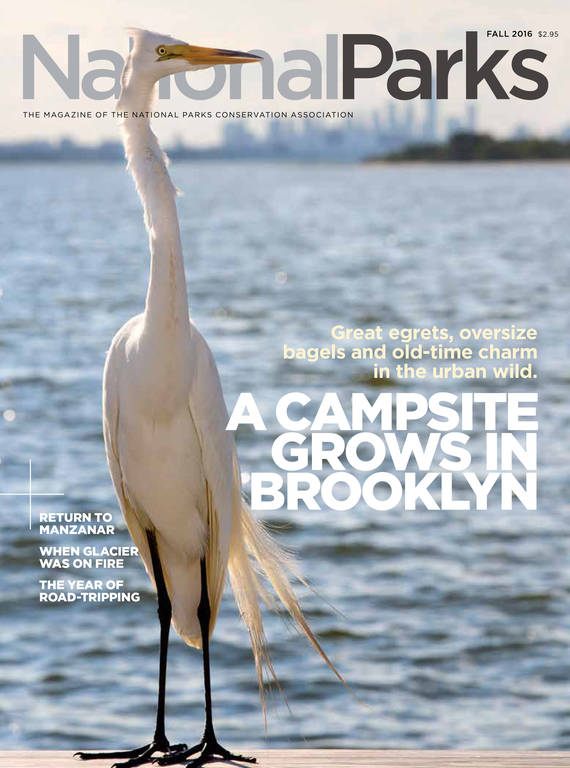Fall 2016
A Campsite Grows In Brooklyn
Snowy egrets, oversize bagels and old-time charm in the city that never sleeps.
When I told my New York friends I was taking the subway to camp at an old airport in Brooklyn, they seemed intrigued. Then I asked if they wanted to join me, and suddenly their calendars were booked up. Let us know how it is, one said. Next time, another promised. I never go to Brooklyn, announced a third. None of them said it — not even the Queens psychologist who did her training in a notorious Brooklyn mental hospital. But it was implied. Camping in Brooklyn? You gotta be nuts.
I would not entirely disagree. Camping at Floyd Bennett Field, a defunct airfield, has all the drawbacks you might expect. It isn’t exactly Yosemite.
And yet: Floyd Bennett, the city’s first municipal airport, has several things to recommend it, starting with the fact that it’s in the middle of Jamaica Bay. Due, in part, to its location on an island-like strip of land, the airport was never particularly successful. It was turned over to the National Park Service in 1971, along with several other sites, and is now included in Gateway National Recreation Area, a 27,000-acre park spanning two states, three boroughs and one enormous estuary.
I was also intrigued by the multiple entreaties on internet travel sites to “take your MetroCard camping.” A national park in New York City is still a national park — it would have exotic birds, tall trees and interesting historical displays. More important, it was a place I could easily return to with my daughters for the price of a couple of bus tickets and subway fares, or a tank of gas. Wildlife organizations and the federal government have been advocating for improved access to outdoor recreation and nature for decades. What could be better than a campground in the middle of everything?
The decision to see the park via public transportation would mean limiting my visit to the Jamaica Bay unit of Gateway, which straddles Brooklyn and Queens. I’d have to return another time to see Sandy Hook, a beachy park with biking trails and a lighthouse in New Jersey, and the Staten Island sites, which include the Fort Wadsworth military base dating back to the American Revolutionary War. As I would learn, getting around the Jamaica Bay area alone would pose enough challenges — and even with a car, I’m not certain I would want to tackle the entire park in a short trip.
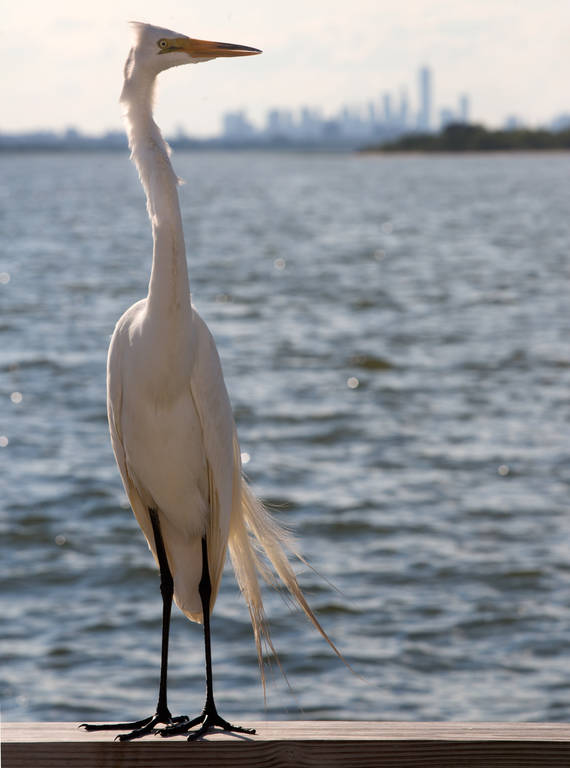
A great egret in New York City’s Jamaica Bay.
© MICHAEL FALCOFortunately, one of my Maryland friends was game. I told Susan that Jamaica Bay is known for its snowy egrets. I might not have mentioned that the waterway had spent more than a century as a dumping ground for everything the city did not want — landfills, sewage, oil, even dead horses. And I can’t quite remember whether I said that the campsite sits next to JFK International Airport. Oh well, I told myself. If New York is the city that never sleeps, maybe we wouldn’t either.
What little I knew about Jamaica Bay came from my father. He grew up on the Rockaway Peninsula in Queens, just over the Marine Parkway Bridge from Floyd Bennett Field. As a teen, he scooped ice cream at the Howard Johnson’s at Jacob Riis Park, an expansive beach that opened in the 1930s and is now part of Gateway. (Named for the famed crusader who pushed the city for better housing conditions, Riis Park was created in honor of immigrants; advocates hoped they would flock to the park and its “People’s Beach.”) Though my dad fished in Jamaica Bay, he never ate his catch. No one did. And he rarely ventured to Floyd Bennett, which was a naval air training facility then. In those days, it sat next to Marine Park, a park in name only. It was, my dad said, nothing more than a landfill — one of many around there.
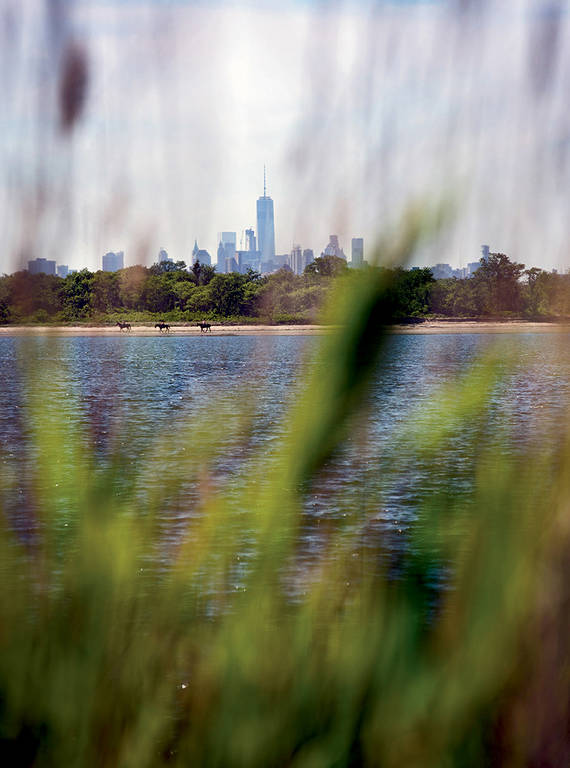
The park’s beaches and marshes can seem a world away from Manhattan, but New York City’s skyline is visible from parts of Gateway, which can be reached via subway and bus.
© MICHAEL FALCOAs a child visiting New York, I remember sitting on my grandparents’ porch and hearing the locals greet each other in thick Queens accents with a sprinkle of Yiddish. My dad would take me to the Fulton Fish Market in Lower Manhattan and walk out with a giant cod fillet smothered in tartar sauce for us to share. Then my mother would take the four children to Alexander’s, a discount store across from Bloomingdale’s, and let us choose a new coat for school.
But the Fulton Fish Market left Fulton Street for the Bronx. My grandmother moved to New Jersey when I was 10, then died when I was 26. Alexander’s went out of business in 1992, and my mom passed away in 2005. None of my New York friends have the Queens accent, including the ones who live in Queens. New York today seems like a fancy, icy cousin who doesn’t much care if I go or stay.
Maybe we would see a snowy egret while camping in Brooklyn. But I was also hoping to glimpse that old New York. Did it still exist?
MetroCard Camping
Susan and I took a three-hour bus trip from Baltimore to New York, the tent in Susan’s wheelie suitcase-turned-backpack. We walked three blocks to Penn Station and took the 2 train to Flatbush Avenue. Then we rode the Q35 bus to Floyd Bennett Field and walked into the Ryan Visitor Center, a former airport terminal that Amelia Earhart and Charles Lindbergh both visited during their heydays as aviators. The center is now a museum about the history of flight, complete with Art Deco transportation posters and knowledgeable rangers.
TRAVEL ESSENTIALS
I had arranged in advance to meet filmmaker and Jamaica Bay advocate Daniel Hendrick at the visitor center. Good thing, because he drove us the long mile to the camp store — a trailer at the end of the old runway — where we checked in and got a map.
The campsites, clustered in shrubbery beyond a parking lot, were deserted except for one man, middle-aged, sitting at the picnic table about 15 feet from our spot. It was hot. He took off his shirt. I tried not to stare at the tattoos on each upper bicep. Was he drinking a Pabst? Did the rules say no beer? Did he know that? Susan and I looked at each other. Who camps in Brooklyn? And alone?
He turned out to be Doug Owen, a Michigan jeweler visiting one of his daughters for her 23rd birthday. She’d recently moved to Brooklyn, where it’s practically impossible to find a hotel for less than $200 a night. Floyd Bennett, in contrast, was only $30.
We immediately liked Doug. He was sensible. Doug, we decided, would protect us. From what, we weren’t sure. But we felt safer with him there than without him.
In 10 minutes, we had the tent up.
Saving Jamaica Bay
“I fell in love with the place, and then I fell in love with the people,” Hendrick said as we headed out together for a tour of the area. As a reporter for the Queens Chronicle, he came to know the residents of the beach communities along the estuary and to understand their battles over better environmental protections. In short, they were trying to save Jamaica Bay’s disappearing salt marshes and force New York City to reduce the amount of nitrogen and phosphorus its sewage plants discharged.
Jamaica Bay had once been productive farmland and home to some of the East Coast’s best oyster beds. But pollution from smokestacks, fish oil factories, fertilizer factories, landfills and horse-rendering plants sullied the waters. The dredging to create Floyd Bennett, JFK Airport and other projects disrupted the ecosystem. Filling in salt marshes to create runways took away crucial habitat and left the shoreline with fewer protections from hurricanes.
Hendrick’s film, “Saving Jamaica Bay,” chronicles the residents’ battles, and his book, “Jamaica Bay,” lays out how the bay became a dumping ground in the first place. He worries that the water could again fall victim to the demands of modernization. JFK Airport could expand its runways, or something more drastic could happen. (Though it was many decades ago, the waterway once narrowly dodged a plan to become a giant port.)
One of the best tour guides for the bay’s natural treasures is Don Riepe, the longtime manager of the Jamaica Bay Wildlife Refuge. Now retired from that job, Riepe still lives in Broad Channel, a feisty community of 3,000 that is the only inhabited island in Jamaica Bay. Many of the residents have waterfront homes and have lived there for decades; Riepe describes himself as a newcomer — after 35 years.
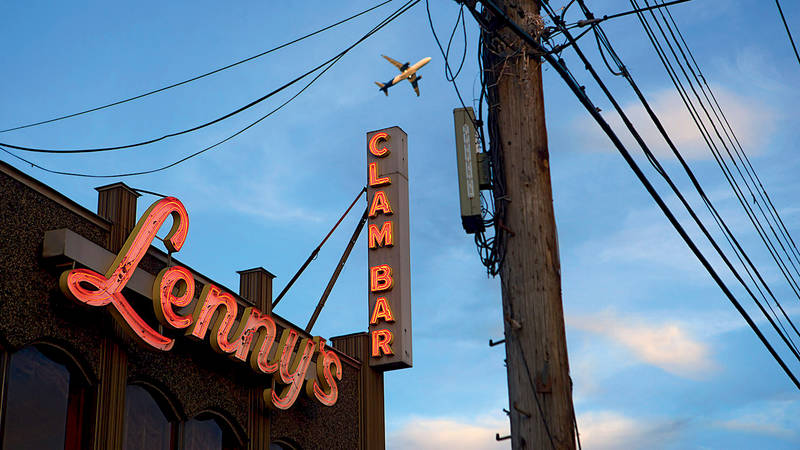
Lenny’s Clam Bar, a well-known restaurant in Howard Beach is a short distance from the park.
© MICHAEL FALCOAs the Jamaica Bay Guardian for the American Littoral Society, Riepe takes out groups to clean up the shoreline, supervises planting projects in marshes that are being restored, installs osprey platforms and nest boxes for barn owls and attends civic meetings about the bay. He offered to show us the refuge at sunset but was having dinner with a cleanup group at Lenny’s Clam Bar in Howard Beach, an Italian enclave east of Floyd Bennett. Would we mind waiting while the group finished eating?
Hendrick dropped us off, and we slid onto bar stools next to an Estonian woman. Susan ordered a ribs appetizer that would have satisfied Tony Soprano, while all around us, large families celebrated communions and graduations. One girl, maybe 10 years old, was dressed like a bride. I asked the bartender, an Irishman named Patrick, if he could make a good Manhattan.
“Best in the city!” he boasted, then stirred the ingredients with a steak knife.
It was delicious, and every time I turned to the Estonian woman, Patrick topped off the martini glass. We talked about kids. Patrick’s wife was expecting their second any day. I ordered a fillet of striped bass on top of buttery mashed potatoes. This was not a bar for the health conscious.
“Kale?” Patrick said when we asked about Brooklyn’s rumored obsession with the vegetable. “Kale is not a food. Kale is a ga-a-h-nish.”
He insisted on wrapping my leftover fillet, but I explained we were camping.
“In New York City?” he asked. He shook his head.
Nature of New York
Riepe, 76, has worked in the Park Service’s only wildlife refuge for more than half his life. He’s helped identify some of the 340-plus bird species and 100 fish species found in Jamaica Bay. While Central Park welcomes more than 40 million people a year, Jamaica Bay’s refuge sees only 50,000. (Gateway as a whole gets 6 million, according to official Park Service statistics; at least a third of those visitors head to Sandy Hook.) That doesn’t bother Riepe.
“It’s here. You find it, fine,” he said. “Let this place grow at its own pace. It’s a wildlife refuge, a special place. We don’t need to drag people here.”
As if on cue, we noticed laughing gulls swoop overhead and horseshoe crabs in the water mating. The New York City skyline emerged to the right; to the left were the high-rises of the Rockaway Peninsula. It was clear that the place where my father grew up is a sandy barrier island that never would be developed today.
Later, we went to Riepe’s home, and he showed us the damage from Superstorm Sandy. Like most of his neighbors, Riepe lost nearly everything. I was about to ask if he ever considered moving when the sun set over his deck. Jamaica Bay became a reflection of amber and orange with the New York skyline in the distance, and I realized I had answered my own question.
Sleep? Fuhgeddaboudit.
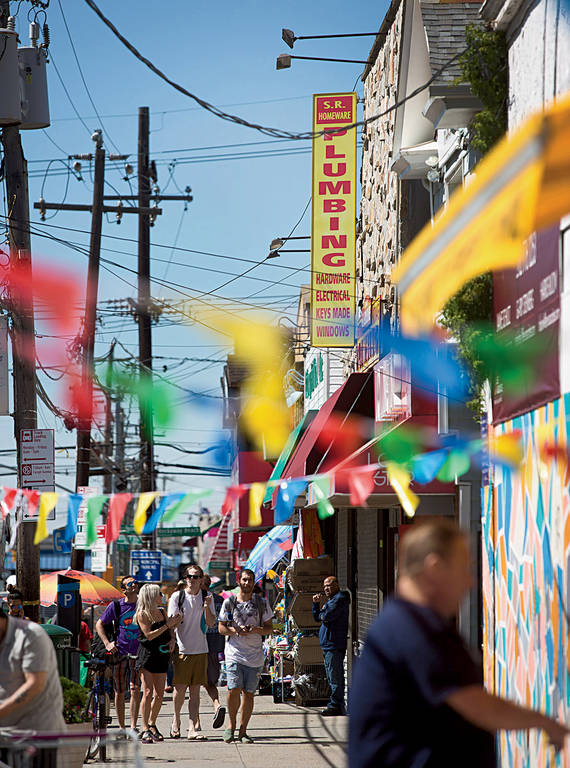
The busy strip at 116th Street in Rockaway Beach.
© MICHAEL FALCOSusan and I woke up at least six times in the night. Once, a helicopter whirled overhead. There were jets from JFK, noise from a nearby carnival, one loud raccoon (Doug the Jeweler thought it was a feral cat, but the next night would prove otherwise), rap music and, finally, chirping birds. In need of coffee and food, we walked the mile to the Q35 and headed to Rockaway Beach. A firefighter at the local engine company directed us to Rockaway Bagels, where Susan got eggs, sausage and pancakes for $5.50. I asked if I could get my lox on a mini-bagel, which was the size of what we Baltimoreans call a regular bagel. Sure, said the Israeli proprietor. But why? I told him I was trying to go low-carb.
“Low carb?” he said. “Fuhgeddaboudit!”
I’d read that the Rockaways had become a hipster haven. But aside from one young man inquiring about the provenance of the garlic, the regulars were a hodge-podge of ordinary New Yorkers: transit workers, mail carriers, nurses.
After we ate, I called my friend the Queens psychologist.
“Where are you?” she asked.
“Rockaway Beach,” I said.
“Oh God,” she replied.
“We went camping last night in Brooklyn,” I reminded her.
“Oh God,” she repeated.
In 22 years in New York City, she had been to Rockaway Beach only once. And she could not come today. Too far.
“Call me next time, when you’re in the city,” she said.
“But this IS the city!” I protested.
We returned to Floyd Bennett Field, where I explored the terminal and several short trails. As I walked around, I pondered something that several people had told me before we arrived: that Gateway had so much potential.
The park seems on the cusp of a new era. It’s not only a large swath of wilderness within a short drive of millions of people, it’s also one of very few in the country that can be reached by bus and subway. Gateway’s superintendent, Jennifer T. Nersesian, has worked on a new park plan that includes adding more bike trails, increasing boating opportunities and improving access to the park. One idea, for example, is shuttle buses from the Flatbush subway; another might be a ferry from Manhattan, as Sandy Hook has in the fall.
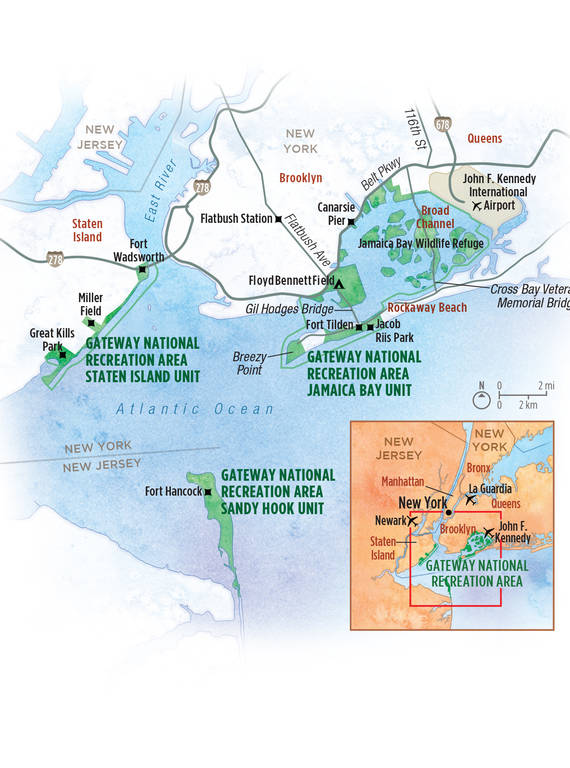
Map: Gateway’s three sites straddle two states and three New York City boroughs.
© KAREN MINOTSome of those changes are underway: For several years, one ranger, John Daskalakis, has guided kayaking trips. The newly constructed Jamaica Bay Greenway biking and walking trail connects Floyd Bennett to the refuge and local beaches.
“We’re named Gateway for a reason,” Nersesian said. “We’re right in the middle of 10 million people. We’re opening up a whole new world of experience and opportunity.”
A Soggy End
I’d met Tom Fox the week before our Gateway excursion, at a conference in France. A ranger at Gateway in the 1970s, Fox was the only person who did not laugh when I told him we would be camping at an airport in Brooklyn, even though it was clearly a change from our accommodations at a seaside gambling resort in Normandy. He offered to pick me up for cocktails at his house in Breezy Point, a housing cooperative within Gateway that’s sometimes referred to as the “Irish Riviera” because of its original settlers.
When Fox pulled up, he said Floyd Bennett looked much as it did in the 1970s. We piled in — me in the front, Susan and our new friend, Doug the Jeweler, in the back. Fox, a jovial fellow who grew up in Flatbush and said he came to love the outdoors while serving in the jungles of Vietnam, narrated a tour of the Rockaways and post-Sandy fortifications. After leaving the Park Service, Fox became an entrepreneur, environmental advocate and zealot for better transit. He’d started the New York Water Taxi. Current plans for a city ferry to Rockaway Beach would bypass Floyd Bennett and that was a mistake, he said: If Gateway and Jamaica Bay were easier to find, more people would fight to preserve them.

Gateway National Recreation Area
Created in 1972, Gateway is located in the outer New York-New Jersey Harbor, protecting more than 26,000 acres of land and offering an array of recreational, cultural and natural experiences.…
See more ›At his house, Fox took out a couple of guitars, and he and Doug the Jeweler played “Louise” while Fox’s wife, Gretchen, sang. Susan and I checked the weather. Rain. I took another swig of rum.
It rained all night and all morning. Susan’s side of the tent was soaked, so she spent the night on a picnic table under a pavilion, locked in a standoff with a raccoon that had reinforcements in the bushes. A ranger had said he’d give us a lift to the Q35. We waited an hour in the rain, as Susan — who had to get home for an event at her son’s school — grew increasingly nervous. The camp store wasn’t open. Neither was the main visitor center. Doug the Jeweler had packed his PT Cruiser too tightly to squeeze us in.
I was trying to sweet-talk the construction workers at a nearby airline hangar into giving us a ride when Susan yelled that she had summoned Uber. In the downpour, she screamed directions into the phone, and we began to flail our arms in a desperate attempt to flag down the driver, who passed the runway a couple of times. When we got in, he said, “This place is really hard to find.”
We dried off as he plugged in the coordinates. He was from Russia, he said. Well, really Tajikistan. When we asked why he came to New York, he said, softly, “More opportunity. For my children.”
About the Photographer
At Penn Station, we ran for it, stopping just long enough to buy some kabob sandwiches from a halal truck when we could see our bus hadn’t yet departed. As we settled in, still panting, I thought of the driver from Tajikistan, and the Estonian woman, and Patrick the Irish bartender in the Italian restaurant. I thought about the kindness of Tom and Gretchen Fox and the little girl dressed like a bride. Together, they captured the beauty of a place where old-timers can thrive and people still come to make a brand-new start of it.
This city still has your back. And yes, it knows how to make a Manhattan. My New York is still there. Who knew I’d have to camp out in Brooklyn to find it?
SIDE TRIP
You don’t have to go all the way to the Rockaways to find a piece of New York from another era. A Lower East Side museum has preserved the American immigrant experience in a way that feels like walking in a time capsule.
While Orchard Street is filled with the requisite expensive coffee shops, juice bars and chic apartments, the Lower East Side Tenement Museum National Historic Site at 97 Orchard (www.tenement.org) tells a different New York story — one where the huddled masses ended up after their harrowing journeys here. It dates back to 1988, when New Yorkers Ruth Abram and Anita Jacobson were searching for a building to house an American immigrant museum. Then Jacobson walked into the Orchard Street building and noticed a sheet-metal ceiling and an aging wooden banister. It was as if someone had blocked the upstairs and left — which is pretty much what had happened. Rather than make the costly improvements required by new housing codes, the landlord had shuttered the upstairs of his Orchard Street building.
The women had discovered an untouched tenement, a testament to the immigrant experience if ever there was one. Four years later, their project became the Tenement Museum. Over the past 25 years, the museum’s staff has restored six tenements. Each tells the story of a different group of immigrants.

National Parks
You can read this and other stories about history, nature, culture, art, conservation, travel, science and more in National Parks magazine. Your tax-deductible membership donation of $25 or more entitles…
See more ›“Shop Life” describes German-Jewish immigrants who opened butchers and ladies’ undergarment shops in the building’s lower levels. In “Hard Times,” visitors learn about the Italian Catholic Baldizzi family, who lived through the Great Depression, as well as the Gumpertz family, German Jews who struggled to survive after the family’s patriarch vanished. “Sweatshop Workers” focuses on the garment industry. “Irish Outsiders” tells the story of the Moores, an immigrant family struggling with discrimination. The museum also offers tours of the neighborhood and the Lower East Side’s signature food shops.
The Tenement Museum may be a time capsule, but the snapshots of immigrants’ lives resonate still. “We have these same stories,” said museum educator Jennean Farmer. “We can see many things that are happening today were happening back then.”
About the author
-
 Rona Kobell Author
Rona Kobell AuthorRona Kobell, a frequent National Parks magazine contributor, is the co-founder of the Environmental Justice Journalism Initiative. She is also a professor of journalism and has written about the Chesapeake Bay for 20 years. Reach her at rona@ejji.org.
